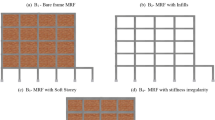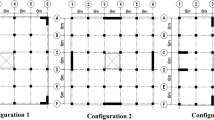Abstract
This research explores the behavior of buildings with reinforced concrete shear walls during strong earthquake ground movements, with a specific focus on how they perform during collapse. The study examines the impact of irregular building plans, dimensions of shear walls, and reinforcement details on their vulnerability to collapse during earthquakes. The buildings are designed according to Iraqi building codes, with additional provisions for capacity design and dynamic amplification. Shear walls are modeled using a multiple vertical line element model that accounts for shear-flexure interaction and uses nonlinear hysteretic material models. Incremental dynamic analysis is employed to simulate the collapse of three-dimensional building models under increasing intensity levels of far field ground motion records from FEMA P695. The study considers plan irregularities of 5%, 8%, and 12% in the design. The results showed that for a constant PGA value of 0.68 g, the probability of failure increases from 83.5 to 98.2% as irregularities in the design increase from 5 to 12% which highlights significant impact of plan irregularities on structural performance during earthquakes.









Similar content being viewed by others
References
Abdelnaby AE, Elnashai AS (2014) Performance of degrading reinforced concrete frame systems under the Tohoku and Christchurch earthquake sequences. J Earthq Eng 18(7):1009–1036
Applied Technology Council (2009) Quantification of building seismic performance factors. Redwood City, USA: FEMA: P695.
Azizi A, Barghian M, Hadidi A, Yaghmaei-Sabegh S (2023) Investigation of structures’ seismic behavior when using the “pendulum column” as an isolator. Asian J Civil Eng. https://doi.org/10.1007/s42107-023-00912-x
Beiraghi H (2018) Near-fault ground motion effects on the responses of tall reinforced concrete walls with buckling-restrained brace outriggers. Scientia Iranica 25(4):1987–1999
Beiraghi H (2019a) Earthquake effect on the concrete walls with shape memory alloy reinforcement. Smart Struct Syst 24(4):491–506
Beiraghi H (2019b) Fragility assessment of shear walls coupled with buckling restrained braces subjected to near-field earthquakes. Steel Compos Struct Int J 33(3):389–402
Beiraghi H (2020) Incremental dynamic analysis of coupled tall reinforced concrete walls subjected to far-field and near-field earthqu. Ingegneria Sismica 37(3):1–27
Beiraghi H, Abadi EM (2023) Energy-based assessment of reinforced concrete walls with two outriggers. Proc Inst Civil Eng Struct Build. https://doi.org/10.1680/jstbu.21.00046
Beiraghi H, Hedayati M (2021) Optimum location of second outrigger in RC core walls subjected to NF earthquakes. Steel Compos Struct Int J 38(6):671–690
Beiraghi H, Kheyroddin A (2022) Effect of plastic zone levels on the responses of concrete shear walls subjected to earthquakes. Proc Inst Civil Eng Struct Build 175(11):865–876
Bekele BN (2022) Effect of setback irregularity on elastic seismic demand of reinforced concrete building. J Univ Shanghai for Sci Technol 24(2):182–193
Cao Y, Wakil K, Alyousef R, Yousif ST, Jermsittiparsert K, Ho LS, Alabduljabbar H, Alaskar A, Alrshoudi F, Mohamed AM (2020) Computational earthquake performance of plan-irregular shear wall structures subjected to different earthquake shock situations. Earthq Struct 18(5):567–580
Elnashai AS, Papanikolaou V, Lee D (2002) ZEUS-NL—A system for inelastic analysis of structures. -Am Earthq Cent Univ Ill Urbana-Champaign Program Release.
Feng DC, Cao XY, Wang D, Wu G (2023) A PDEM-based non-parametric seismic fragility assessment method for RC structures under non-stationary ground motions. J Build Eng 63:105465
Firdose HA, Kumar AS, Narayana G, Narendra BK (2022, March). Study on dynamic behaviour of irregular RC framed structures with different location of shear walls. In IOP Conference Series: Earth and Environmental Science (Vol. 982, No. 1, p. 012076). IOP Publishing.
Ghodsi T, Flores Ruiz JA (2010) Pacific earthquake engineering research/seismic safety commission tall building design case study 2. Struct Des Tall Spec Build 19(1–2):197–256
Gomes A, Appleton J (1997) Nonlinear cyclic stress-strain relationship of reinforcing bars including buckling. Eng Struct 19(10):822–826
Goto H, Morikawa H (2012) Ground motion characteristics during the 2011 off the pacific coast of Tohoku earthquake. Soils Found 52(5):769–779
Huang Z, Zhao D (2013) Mechanism of the 2011 Tohoku-Oki earthquake (Mw 9.0) and tsunami: insight from seismic tomography. J Asian Earth Sci 70–71:160–168
Jebelli ST, Behnam B, Tehrani P (2022) Seismic design of setback irregular steel structures based on life cycle cost. Sci Rep 12(1):16784
Ji J, Elnashai AS, Kuchma DA (2007) An analytical framework for seismic fragility analysis of RC high-rise buildings. Eng Struct 29(12):3197–3209
Ji J, Elnashai AS, Kuchma DA (2009) Seismic fragility relationships of reinforced concrete high-rise buildings. Struct Design Tall Spec Build 18(3):259–277
Kazama M, Noda T (2012) Damage statistics (summary of the 2011 off the pacific coast of Tohoku earthquake damage). Soils Found 52(5):780–792
Koduru SD, Haukaas T (2009) Probabilistic seismic loss assessment of a Vancouver high-rise building. J Struct Eng 136(3):235–245
Kumar SSBS, Rao GVR, Raju PM (2016) Seismic fragility analysis of regular and setback RCC frames—A few hypothetical case studies. Asian J Civ Eng 17(5):551–569
Labibzadeh M, Basiri A, Khajehdezfuly A, Hosseinlou F, Khayat M, Khademalrasoul A (2023) Effect of arrangement of shear walls on the fragility curves of RC frames subjected to sequential earthquake excitations. Iran J Sci Technol Trans Civil Eng. https://doi.org/10.1007/s40996-023-01265-w
Lee J, Fenves G (1998) Plastic damage model for cyclic loading of concrete structures. J Eng Mech 124(8):829–900
Li W, Li QN, Zhao JL (2018) Experimental study of T-shaped RC shear wall subjected to cyclic loading. Iran J Sci Technol Trans Civil Eng 42:191–198
Menegotto M, Pinto P (1973) Method of analysis for cyclically loaded RC plane frames including changes in geometry and non-elastic behavior of elements under combined normal force and bending. In: Symposium Resistance and Ultimate Deformability of Structures Acted on by Well Defined Repeated Loads. IABSE Reports. Vol 13. Lisbon.
Mouhine M, Hilali E (2022) Seismic vulnerability assessment of RC buildings with setback irregularity. Ain Shams Eng J 13(1):101486
Nazari YR, Saatcioglu M (2017) Seismic vulnerability assessment of concrete shear wall buildings through fragility analysis. J Build Eng 12:202–209
Nemutlu ÖF, Sari A, Balun B (2023) A Novel approach to seismic vulnerability assessment of existing residential reinforced concrete buildings stock: a case study for bingöl, Turkey. Iran J Sci Technol Trans Civil Eng 47(6):3609–3625
Omidian P, Saffari H (2018) Comparative analysis of seismic behavior of RC buildings with shape memory alloy rebar in regular, torsional irregularity and extreme torsional irregularity cases. J Build Eng 20:723–735
Onur T, Gok R, Abdulnaby W, Shakir AM, Mahdi H, Numan N, Abd NA (2016) Probabilistic seismic hazard assessment for Iraq (No. LLNL-TR-691152). Lawrence Livermore National Lab.(LLNL), Livermore, CA (United States).
Phadnis PP, Karjinni VV (2019) Fragility curves for steel–concrete composite shear wall building with torsional irregularity. Asian J Civil Eng 20:1163–1178
Sadraddin HL, Shao X, Hu Y (2016) Fragility assessment of high-rise reinforced concrete buildings considering the effects of shear wall contributions. Struct Design Tall Spec Build 25(18):1089–1102
Salmassi MA, Kheyroddin A, Hemmati A (2023) Enhancement of the performance of two tall buildings with end shear walls using nonlinear time history analysis: a case study. Iran J Sci Technol Trans Civil Eng. https://doi.org/10.1007/s40996-023-01289-2
Sattar S, Liel AB (2016) Seismic performance of nonductile reinforced concrete frames with masonry infill walls—I: Developm.
Shamrao PV (2021) Seismic fragility analysis for Torsionally imbalanced Shear Wall concrete building. J Inst Eng (india): Ser A 102(2):553–563
Shendkar MR, Kontoni DPN, Mandal S, Maiti PR, Tavasoli O (2021) Seismic evaluation and retrofit of reinforced concrete buildings with masonry infills based on material strain limit approach. Shock Vib 2021:1–15
Shendkar MR, Kontoni DPN, Işık E (2023) Determination of the seismic vulnerability of infilled RC buildings according to the Quadrants assessment method. Asian J Civil Eng. https://doi.org/10.1007/s42107-023-00904-x
Takewaki I, Murakami S, Fujita K, Yoshitomi S, Tsuji M (2011) The 2011 off the pacific coast of Tohoku earthquake and response of high-rise buildings under long period ground motions. Soil Dyn Earthq Eng 31:1511–1528
Wallace JW (2012) Behavior, design, and modeling of structural walls and coupling beams—lessons from recent laboratory tests and earthquakes. Int J Concr Struct Mater 6(1):3–18
Wang N, Huang X, Zhang D (2021) Seismic fragility assessment of RC plan-asymmetric wall-frame structures based on the enhanced damage model. Shock Vib 2021:1–17
Yaghmaei-Sabegh S (2023) Energy content analysis of the large 2019 Ridgecrest, California seismic sequence. J Earthq Tsunami. https://doi.org/10.1142/S1793431123500306
Yaghmaei-Sabegh S, Shoghian Z, Neaz Sheikh M (2014) A new model for the prediction of earthquake ground-motion duration in Iran. Nat Hazards 70:69–92
Yaghmaei-Sabegh S, Neekmanesh S, Lam N, Amirsardari A, Taghizadieh N (2023a) An equivalent linear SDOF system for prediction of nonlinear displacement demands of non-ductile reinforced concrete buildings with shear walls. Struct Eng Mech 85(5):655
Yaghmaei-Sabegh S, Neekmanesh S, Lam N, Amirsardari A, Taghizadieh N (2023b) Seismic demands prediction for low-and mid-rise RC shear wall-frame structures. Iran J Sci Technol Trans Civil Eng. https://doi.org/10.1007/s40996-023-01294-5
Yazdanpanah O, Formisano A, Chang M, Mohebi B (2021) Fragility curves for seismic damage assessment in regular and irregular MRFs using improved wavelet-based damage index. Measurement 182:109558
Zade NP, Sarkar P, Davis R (2023) Seismic assessment of vertical geometric irregular building: a revisit. Iran J Sci Technol Trans Civil Eng 47(4):2247–2262
Zareian F, Krawinkler H (2010) Structural system parameter selection based on collapse potential of buildings in earthquakes. J Struct Eng 136(8):933–943
Zhao D (2015) The 2011 Tohoku earthquake (Mw 9.0) sequence and subduction dynamics in western pacific and east Asia. J Asian Earth Sci 98:26–49
Author information
Authors and Affiliations
Contributions
All persons who meet authorship criteria are listed as authors, and all authors certify that they have participated sufficiently in the work to take public responsibility for the content, including participation in the concept, design, analysis, writing, or revision of the manuscript.
Corresponding author
Ethics declarations
Conflict of interest
On behalf of all authors, the corresponding author states that there is no conflict of interest.
Rights and permissions
Springer Nature or its licensor (e.g. a society or other partner) holds exclusive rights to this article under a publishing agreement with the author(s) or other rightsholder(s); author self-archiving of the accepted manuscript version of this article is solely governed by the terms of such publishing agreement and applicable law.
About this article
Cite this article
AL-saedi, M.a.h., Yaghmaei-Sabegh, S. Seismic Vulnerability Assessment of Regular and Irregular Reinforced Concrete Shear Wall Buildings Using Fragility Curves. Iran J Sci Technol Trans Civ Eng (2024). https://doi.org/10.1007/s40996-024-01435-4
Received:
Accepted:
Published:
DOI: https://doi.org/10.1007/s40996-024-01435-4




